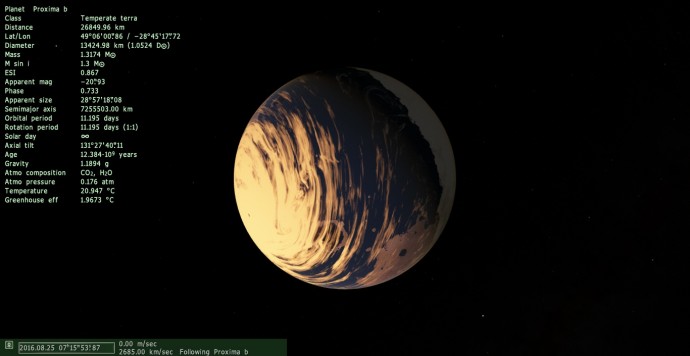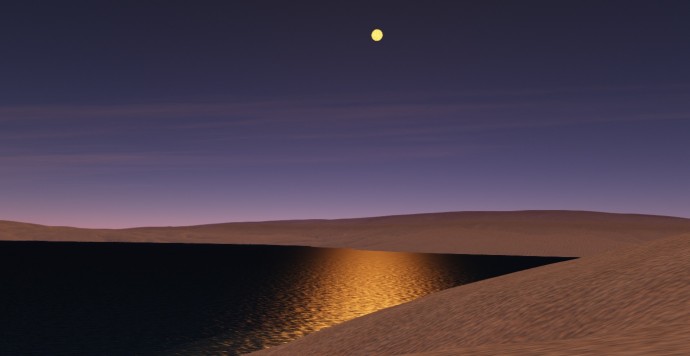|
Exoplanet News Thread
|
|
| spacer | Date: Wednesday, 24.08.2016, 20:25 | Message # 241 |
 Star Engineer
Group: Users
 Israel
Israel
Messages: 1258
Status: Offline
| simonecinque1992, its artist work. you couldnt know how it looks like exactly without been there 
maybe in the future with super telescopes we will be able to detect features on the planet to help us understand how it really looks like and made off
"we began as wanderers, and we are wanderers still"
-carl sagan
-space engine photographer
|
| |
| |
| PlutonianEmpire | Date: Wednesday, 24.08.2016, 21:44 | Message # 242 |
 Pioneer
Group: Users
 United States
United States
Messages: 475
Status: Offline
| I looked at the table provided by the paper, and it said the Eccentricity for Proxima B was <0.35. Does that mean the eccentricity *is* 0.35 or anwhere between 0 and 0.35?
Specs: Dell Inspiron 5547 (Laptop); 8 gigabytes of RAM; Processor: Intel® Core™ i5-4210U CPU @ 1.70GHz (4 CPUs), ~2.4GHz; Operating System: Windows 7 Home Premium 64-bit; Graphics: Intel® HD Graphics 4400 (That's all there is :( )
|
| |
| |
| Hornblower | Date: Wednesday, 24.08.2016, 22:51 | Message # 243 |
 World Builder
Group: Users
 United States
United States
Messages: 714
Status: Offline
| Ok place your bets people!
What type of planet do you think Proxima b is?
I think it's going to be either a desert or a selena
|
| |
| |
| Mosfet | Date: Wednesday, 24.08.2016, 22:51 | Message # 244 |
 World Builder
Group: Users
 Italy
Italy
Messages: 754
Status: Offline
| I think it means that 0.35 it's a lower measurement limit posed by the method used to take the measure, so right now with data at our disposal, we can only say that eccentricity is less than 0.35
"Time is illusion. Lunchtime doubly so."
Douglas N. Adams
My mods
Asus x555ub: cpu i5-6200u - ram 4gb - gpu nvidia geforce 940m 2gb vram
|
| |
| |
| Ştefan | Date: Thursday, 25.08.2016, 07:23 | Message # 245 |
|
Astronaut
Group: Users
 Romania
Romania
Messages: 44
Status: Offline
| I made a little code for Proxima Centauri and Proxima b
Be careful through, I had to remove the Hipparcos entry for Proxima, as it spawned alongside this new version of Proxima, and I couldn't correct the luminosity of the Hipparcos entry.
Here are some pictures of Proxima b:


Oddly enough, its temperature (with that neglijible 2 degrees greenhouse) varies between 12 and 66 degrees Celsius... much higher than I expected with the data from ESO. Its stellar flux is only 63% of that of Earth, shouldn't it be colder?...
Anyway, for the unknown eccentricity, I put half of 0.35, namely 0.175.
Edited by Ştefan - Thursday, 25.08.2016, 08:42 |
| |
| |
| n0b0dy | Date: Thursday, 25.08.2016, 09:21 | Message # 246 |
 Explorer
Group: Users
 Pirate
Pirate
Messages: 297
Status: Offline
| How do they plan to slow down the space-chips once they reach proxima century and start to approach the planet in question? Assuming (some of them) manage to get there intact in there first place 
|
| |
| |
| spacer | Date: Thursday, 25.08.2016, 09:32 | Message # 247 |
 Star Engineer
Group: Users
 Israel
Israel
Messages: 1258
Status: Offline
| n0b0dy, for what i know, i think its gonna do just a flyby with the huge speed.
but i am not sure about it
"we began as wanderers, and we are wanderers still"
-carl sagan
-space engine photographer
|
| |
| |
| FastFourierTransform | Date: Thursday, 25.08.2016, 09:42 | Message # 248 |
 Pioneer
Group: Local Moderators
 Spain
Spain
Messages: 542
Status: Offline
| Quote n0b0dy (  ) How do they plan to slow down the space-chips once they reach proxima century
The idea of Breakthrough Starshot is to make ultrafast fly-bys, not to slow down at the destination. Slowing down from 20% of the speed of light to a velocity that enables orbit insertion would be quite fantastic and difficoult. The perfect situation would be placing lasers in the Proxima Centauri system (lunching them at slow speeds and reaching the system thousands of years later) and use them as breaks for the space-chips when they arrive. The nano-spacecrafts can't slow down from themselves (meaning by that with their own propulsion and rocketery) because they would have to be much more massive (if we imagine that a relativistic slow-down can even be made in near future) and thus slower in the first place.
But a slowdown operated by external means could be the solution. I red somewhere that there are some ideas to slow down the nano spacecrafts: making a close aproach to the star with the solar sail correctly oriented could help slowing down a lot by radiation pressure. Using a electrified solar sail with a variable potential could create a small magnetic field around the space-chip that, if deployed in the exact time, strenght and orientation, could be repelled by the stellar magnetosphere and then the planetary stronger magnetosphere, so the spacecraft would slow down enourmously. But all of this is just conjecture. And we would have to wait to some fly-bys first (if the idea is even feasible). We could even vary the electric potential of the sail in such a way that the electric charged particles emmited by the star (stellar wind) get deflected from the spacecraft (enabling in one hand to slow down because of thirds newton law and in the other enabling to diminiss the stellar wind flux over the space-chip and thus avoiding frying it) 
Edited by FastFourierTransform - Thursday, 25.08.2016, 09:47 |
| |
| |
| Salvo | Date: Thursday, 25.08.2016, 16:52 | Message # 249 |
 Star Engineer
Group: Local Moderators
 Italy
Italy
Messages: 1400
Status: Offline
| Everyone keeps saying that the planet receives 400 times more x-ray radiation than we receive on earth, even if the stellar flux is 0.7. But... why?
I mean: I know for sure that red dwarfs emits way less x-ray radiation, compared to other wavelengths, than a G type star. So what's the matter? Does the UV radiation loses energy more quickly with distance than... red light for example? 
The universe is not required to be in perfect harmony with human ambition.
CPU: Intel Core i7 4770 GPU: ASUS Radeon R9 270 RAM: 8 GBs
(still don't know why everyone is doing this...)
|
| |
| |
| Ştefan | Date: Thursday, 25.08.2016, 19:07 | Message # 250 |
|
Astronaut
Group: Users
 Romania
Romania
Messages: 44
Status: Offline
| Because Proxima Centauri is a flare star, it is much more active than a normal star of its size.
|
| |
| |
| Watsisname | Date: Thursday, 25.08.2016, 20:39 | Message # 251 |
 Galaxy Architect
Group: Global Moderators
 United States
United States
Messages: 2613
Status: Offline
| It's their magnetic activity. Red dwarfs have cooler surfaces, so they emit less light with a spectrum which peaks at longer wavelengths, but they also have more UV and x-ray emission because they have more intense coronal activity and flares.
Quote Salvo (  ) Does the UV radiation loses energy more quickly with distance than... red light for example? wacko
No, all wavelengths travel equally well through space.  It could be tempting at first to conclude that, since we see distant stars are redder (interstellar reddening), but this is an effect of absorption of bluer light by dust. Distant galaxies also look redder, but this is an effect of the cosmic expansion which decreases the photon energy. It could be tempting at first to conclude that, since we see distant stars are redder (interstellar reddening), but this is an effect of absorption of bluer light by dust. Distant galaxies also look redder, but this is an effect of the cosmic expansion which decreases the photon energy.

|
| |
| |
| Salvo | Date: Friday, 26.08.2016, 14:55 | Message # 252 |
 Star Engineer
Group: Local Moderators
 Italy
Italy
Messages: 1400
Status: Offline
| Quote Watsisname (  ) they have more intense coronal activity and flares.
This explains it very well... I'm quite ignorant for what concerns stars behavior, mainly what happens inside them. I always found that topic pretty difficult, also because there are many things (like heating of the solar corona) that currently aren't fully understood. 
Anyway, I seriously hope this planet has a quite massive atmosphere, even if it could be completely gone because of its proximity to the star. Also the atmosphere should protect from X-ray and UV radiation, but what is lacking in this planet might be the magnetic field, and in that case we wouldn't have many chances to move there in the future, we wouldn't have a better environment than the one of Mars, for example.
The universe is not required to be in perfect harmony with human ambition.
CPU: Intel Core i7 4770 GPU: ASUS Radeon R9 270 RAM: 8 GBs
(still don't know why everyone is doing this...)
Edited by Salvo - Friday, 26.08.2016, 14:56 |
| |
| |
| Spock1108 | Date: Friday, 26.08.2016, 21:10 | Message # 253 |
|
Space Tourist
Group: Users
 Antarctica
Antarctica
Messages: 38
Status: Offline
| Quote Quote Ştefan (  ) I made a little code for Proxima Centauri and Proxima b
Be careful through, I had to remove the Hipparcos entry for Proxima, as it spawned alongside this new version of Proxima, and I couldn't correct the luminosity of the Hipparcos entry.
Here are some pictures of Proxima b:
Oddly enough, its temperature (with that neglijible 2 degrees greenhouse) varies between 12 and 66 degrees Celsius... much higher than I expected with the data from ESO. Its stellar flux is only 63% of that of Earth, shouldn't it be colder?...
Anyway, for the unknown eccentricity, I put half of 0.35, namely 0.175.
An atmosphere of 0.17 atmospheres is a little bit ... and also the temperature without greenhouse effect is not of 1 degree but of -30 ...
Sorry for my English! ;)
|
| |
| |
| simonecinque1992 | Date: Saturday, 27.08.2016, 10:22 | Message # 254 |
 Pioneer
Group: Users
 Italy
Italy
Messages: 470
Status: Offline
| spacer, Oh, thx. (it looked so realistic to me.)
My Mods and Addons
Packard Bell
Windows 10 Pro
Intel® Celeron® CPU 1000M @ 1.80GHz 1.80 GHz
4 GB
64 bit Operative System
Edited by simonecinque1992 - Saturday, 27.08.2016, 10:22 |
| |
| |
| midtskogen | Date: Saturday, 27.08.2016, 18:25 | Message # 255 |
 Star Engineer
Group: Users
 Norway
Norway
Messages: 1674
Status: Offline
| I find it more than a bit silly how this Proxima Centauri planet is portrayed in the media. The truth is that we know very little about it and nothing about its atmosphere. And what we do know tells us that the planet is likely far from anything Earth-like. Its sun is nothing like our trusty sun. The planet receives most of its radiation in infra-red. And Proxima Centauri's massive magnetic field and the resulting UV and X-ray eruptions would fry any life as we know it, and quite possibly long ago have stripped it of the planet's atmosphere.
If this planet ever is verified to be "habitable", it would be a huge surprise.
NIL DIFFICILE VOLENTI

|
| |
| |